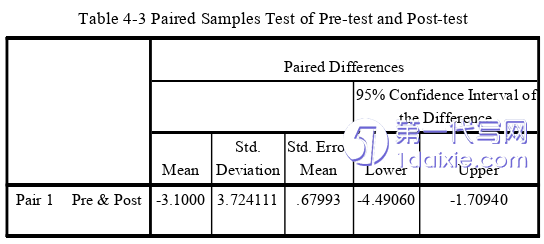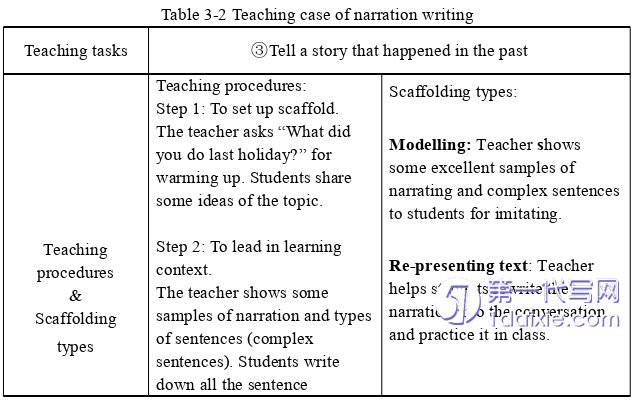本文是一篇英语论文,在进行研究之前,我们根据日常观察和教学经验,假设支架式教学可能是英语写作教学中一种有效的教学方法。我们对它对四种体裁和写作的四个方面的影响进行了一些假设。
Chapter One Introduction
1.1 Research background
With globalization and the developing trend of education for the contemporaryworld,English learning has become more of significance nowadays,which is widelyregarded as an essential skill of learning and communication.Writing ability is notonly an important part of English communicative ability but also an essential standardto measure the comprehensive language competence of senior high school students.

However,the current situation of English writing in senior high school is farfrom satisfactory.From the perspective of teaching environment,compared withnative language writing supported by a large number of sufficient conditions,Englishwriting teaching is mostly carried out at school.Even with the influence of Englishmedia,there are lots of restrictions for teachers to provide a vivid languageenvironment for students to make practice anytime and anywhere.The relatedknowledge students accept is mainly from teachers,which is too limited for studentsto expand their thinking and achieve knowledge internalized.Normally,the teachingobjectives focus on the outcomes students make,and the standards emphasize thestructure and grammar of compositions,which have little effect on stimulatingstudents’writing aspirations and developing basic writing strategies.Most of thestudents’English writing training is for examinations,not for students’own practicalcommunication needs.
Furthermore,it is admitted that single evaluation method is not always applicablein all kinds of complicated teaching and learning conditions to value students’dynamic development,but to grade students’compositions is still the most commonway as teaching evaluation in Chinese senior high school.The traditionalproduct-based teaching approach,which emphasizes the accuracy,structure andrhetoric of writing outcomes,is the most widely used approach in English writingteaching in China,especially in senior high school.
1.2 Research purpose and significance
English writing teaching has been a vital part of English teaching in senior highschool.Given the situation described above about English writing,to achieve theultimate aim of improving the quality of English writing teaching,we selectscaffolding instruction as the research topic and go on further exploration in thisresearch field.
Before carrying out the research,according to related studies on the topic,wecome up with some questions about the teaching effect of scaffolding instruction inEnglish writing.The research is conducted around the following two questions:
1.Does scaffolding instruction have an effect on English writing teaching insenior high school?
2.When scaffolding instruction is applied into English writing teaching class,are its effects on description,narration,exposition and argumentation the same?Whatare the differences?What are its effects on structure,unity,cohesion andappropriateness?What is the intensity of its effects?
On the theoretical level,as the studies of scaffolding instruction in Chinesesenior high school are limited,the research may enrich the theories of English writingteaching for future paper writing and help teachers to have a deep understanding ofscaffolding instruction.On the practical level,the research intends to provide somenew ideas and suggestions for the field of English writing teaching in senior highschool.It is expected that the situation of low-efficiency teaching and learning inEnglish writing class could be changed.
Chapter Two Literature Review
2.1 Scaffolding instruction
Since Wood,Bruner,and Ross first proposed the concept of scaffolding in the1970s,it has attracted great attention in the field of SLA.With the continuousenrichment and improvement of those studies on scaffolding theory,scaffoldinginstruction has been developed into one of the mature teaching approaches underconstructivism theory.
2.1.1 The definition of scaffolding instruction
With regard to the definition and understanding of scaffolding,opinions havevaried throughout history.The term is first used by Wood,Bruner,and Ross(1976)intheir experiment of parent-child talk in the early years.They believe that“scaffolding,in its more usual sense,is a temporary structure that is put up in the process ofconstructing or repairing a building”(Gibbons,2002:16).
Then it is developed as“teachers and other more capable peers are to provideand offer students with appropriate help and assistance to make them reach the nextstage or level”(Raymond,2000:49).According to Pearson and Fielding(1991:842),“scaffolds”are“what teachers say and do to enable children to complete mental tasksthey could not complete without assistance.”Donato(1994:76)defines it as“thecollaboration between learners and experts in the area of learners’ZPD.”Gravesthinks it is“a temporary supportive structure that teachers create to assist a student ora group of students to accomplish a task that they could not complete alone”(Graves&Watts,1994:44)
2.2 Zone of proximal development
In the early 1930s,the former Soviet Union learning theorist and psychologistLev Vygotsky came up with the concept of“zone of proximal development(ZPD)”and defined it as“the distance between the actual developmental level as determinedby independent problem solving and the level of potential development as determinedthrough problem solving under adult guidance,or in collaboration with more capablepeers”(Vygotsky,1978:86).He holds the idea that“what a child can do withassistance today she will be able to do by herself tomorrow”(Vygotsky,1978:87).Similarly,Raymond(2000:176)regards ZPD as“the difference between the child’sability to do things independently and the ability with the help of others”.Vygotsky(1978)finds that children have two levels of cognitive development,namely,the actual developmental level and the zone of proximal development.The actual level isthe development stage of children proposed by Piaget.The ZPD is the potential levelto be reached through adults’guidance or collaboration with more capable peers.
Tharp and Gallimore(1988)consider the ZPD as a four-stage process:stage 1:assistance provided by more knowledgeable others;stage 2:assistance provided byself;stage 3:automatization through practice;stage 4:de-automatization;recursiveness through previous three stages.To be specific,in the first stage,studentsrely on others or peers who are more proficient to learn new things.In the secondstage,students master knowledge rules and can complete tasks by their abilitieswithout the help of others.In the third stage,students achieve knowledge internalizedand complete tasks independently.At the same time,the learning outcomes areassimilated,which is the stage of“once learn,you will never forget”.In the fourthstage,students are likely to fail to complete new tasks on their own and then recyclethe previous stages.That is how ZPD works in the learning process.
Chapter Three Scaffolding Instruction in English Writing Teaching in Senior HighSchool.........................16
3.1 The teaching contents of English writing...................................16
3.1.1 The four genres of writing..............................16
3.1.2 The four aspects of composition..............................17
Chapter Four Research Process and Results............27
4.1 Research methods........................27
4.1.1 Composition analysis..........................27
4.1.2 Test analysis..............................................28
Chapter Five Suggestions for English Writing Teaching...................42
5.1 The major findings of research.................................42
5.2 Suggestions for English writing teaching....................................43
Chapter Five Suggestions for English Writing Teaching
5.1 The major findings of research
According to the research results,we would like to report the following majorfindings about the effect of scaffolding instruction.
Firstly,scaffolding instruction has a significant effect on English writingteaching in senior high school.In the class with scaffolding instruction,in general,students’scores have been improved significantly from the pre-test to the post-test(see the data analysis of 4.2.1).In detail,the gap of scores in the class becomessmaller,and the students who had the lowest score succeed in getting higher scores atthe end of the semester,which shows scaffolding instruction is not only effective tothose proficient students in English writing,but also conducive to the students who donot have a good command of English knowledge.In the writing class with scaffoldinginstruction,the students can obtain and enhance their abilities to handle correctly andcomprehensively different genres of writing.In the meantime,they are stimulated towrite independently and finally get further efforts.

Also,we can get other evidence to prove its effect on students’attitudes andinterest from the questionnaires and interviews(see the data analysis of 4.2.4).It isshown that most of the students attach due importance to English writing,which is agood phenomenon in English writing learning in senior high school.Moreover,thestudents can make a lot of progress in knowledge of structure and grammar if they canuse the keywords and the phrases appropriately.
Chapter Six Conclusion
6.1 Summary of major findings
Before carrying out the research,we hypothesize that scaffolding instruction maybe an effective teaching approach in English writing teaching according to dailyobservations and teaching experiences.And we makes some assumptions about theintensity of its effect on four genres and four aspects of writing.
The statements enumerated from the results of the research above can be resultedin a conclusion that scaffolding instruction is effective in English writing teaching insenior high school.It has a significant effect on improving students writing abilities.
According to the intensity of effect of scaffolding instruction,the four genres ofwritings can be ordered as:narration>description>exposition>argumentation(seeanalysis of 4.2.2).Four aspects of compositions can be ordered as:structure>unity>cohesion>appropriateness(see analysis of 4.2.3).The application of scaffoldinginstruction also brings some unexpected problems with cooperative learning andevaluation methods.For that,some according suggestions are given with regards toeach problem.
reference(omitted)
